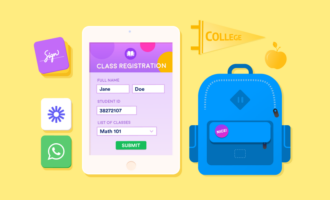Creating online progress reports
- Student information
- Class, subject, and grade level
- Grades
- Comments/solutions
Being a teacher has always been challenging — and finding time to collect and manage student progress data can seem downright impossible. To tackle the challenge, some teachers use checklists to track assignments, grades, attendance, and participation, while others rely solely on classroom observations, metrics like standardized test results, or a combination of all of the above, including comparing their notes with students’ self-evaluations.
While there’s no perfect way to track student data, online form builder Jotform can help streamline the process for you — or even help you create a system — with more than 1,900 education form templates to get you started. Plus, thanks to Jotform’s integrations with 100-plus popular apps (like Google Drive, Dropbox, and Zoom), you can take your forms and your teaching skills to the next level.
Here are four form fields to include when creating online progress reports for students.
1. Student information
Though it sounds obvious, the best way to start tracking each student’s progress is by making sure you’re tracking the right student. By adding each student’s name (and student ID, if they have one) to their online progress report, you can keep everything associated with them organized in one place.
2. Class, subject, and grade level
If you only teach one class, this field is probably unnecessary. But if you teach various subjects to the same 25 students all day, students in several grade levels, or a class with many modules (like a journalism class with separate projects like yearbook, newspaper, and website), it’s important to designate which subject you’re evaluating the student in.
Tracking this data helps you identify trends and make adjustments. For example, maybe one student is acting up in science (but not other subjects) because they’re struggling with the material.
3. Grades
This is an obvious one, of course, but your students’ grades (whether you use letter grades, pass/fail, or pluses and minuses) must be part of their online progress reports. Additionally, with this form field in Jotform, you can add a dropdown field called “areas of concern,” for instance, to remind yourself how each student ended up with their grade (and to explain it to their parents). For example, you might select an option to remind you that Johnny got a D in math this semester as a result of his lack of focus or disruptive behavior, not his academic ability.
4. Comments/solutions
This last form field — or these last two form fields, if you choose to separate them — is one of the most important, because it gives you the opportunity to offer more nuanced feedback instead of boiling everything down to a series of grades. Here, you can address any comments and concerns you may have about a student, including their strengths, weaknesses, and noticeable improvements. It’s also a great space to jot down any solutions that come to mind — ideas you’ve either already tried or would like to implement in the future — to improve the student’s grades, attitude, or overall conduct.
Now that you know what to include in your online progress reports, Jotform can help you build one. You can either create one from scratch or use one of these fully customizable templates.
- Student progress report: With this customizable form template, you can monitor a student’s progress, thanks to questions and dropdown menus that allow you make in-depth notes about their strengths and weaknesses.
- Student progress tracking sheet: Track and manage your students’ performance with this simple, fully customizable student tracking sheet template through Jotform Tables. You can connect this table template to your progress report forms to populate it automatically to organize your data and track student progress. Though it’s split into different tabs for each of your students, feel free to add (or delete) rows and columns as you see fit so it’s organized perfectly for your needs.
With different viewing options — like table, calendar, card, or upload view — and the ability to import external files, you’ll have everything you need to keep track of your students in one place.
- Student progress evaluation: Because this form template already includes important fields — name, subject, grades, and rating scales for things like behavior and tardiness — it’s a great way to structure your classroom assessments. And if you’d like something more complex on the evaluation, you can always drag and drop questions or additional fields in the Jotform Form Builder.
Jotform can help alleviate some of the stress of being a teacher with an easy way to build and track online progress reports. With Jotform’s customizable form templates, you can start tracking and managing your students’ progress in minutes.
Photo by Yan Krukau






































































































Send Comment:
1 Comments:
240 days ago
I need progress report card